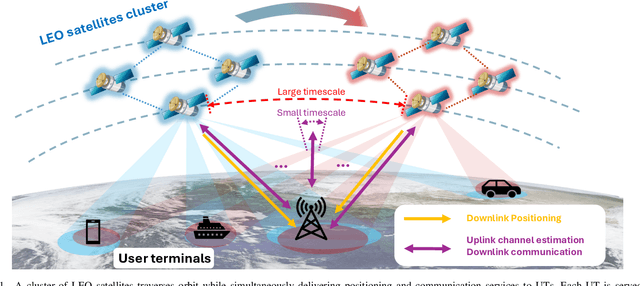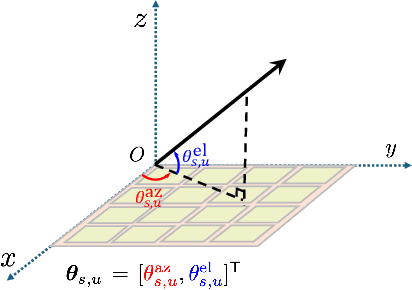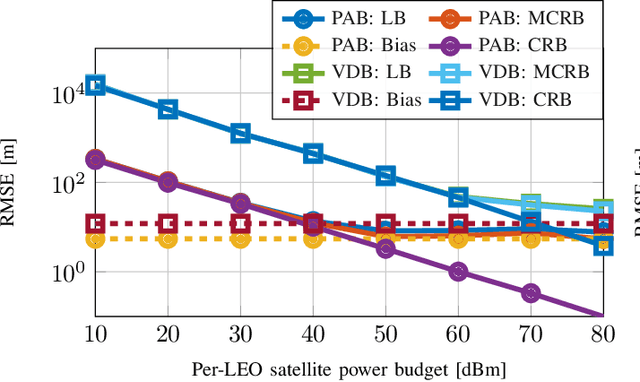Pinjun Zheng
Tri-Hybrid Multi-User Precoding Using Pattern-Reconfigurable Antennas: Fundamental Models and Practical Algorithms
May 13, 2025Abstract:The integration of pattern-reconfigurable antennas into hybrid multiple-input multiple-output (MIMO) architectures presents a promising path toward high-efficiency and low-cost transceiver solutions. Pattern-reconfigurable antennas can dynamically steer per-antenna radiation patterns, enabling more efficient power utilization and interference suppression. In this work, we study a tri-hybrid MIMO architecture for multi-user communication that integrates digital, analog, and antenna-domain precoding using pattern-reconfigurable antennas. For characterizing the reconfigurability of antenna radiation patterns, we develop two models -- Model~I and Model~II. Model~I captures realistic hardware constraints through limited pattern selection, while Model~II explores the performance upper bound by assuming arbitrary pattern generation. Based on these models, we develop two corresponding tri-hybrid precoding algorithms grounded in the weighted minimum mean square error (WMMSE) framework, which alternately optimize the digital, analog, and antenna precoders under practical per-antenna power constraints. Realistic simulations conducted in ray-tracing generated environments are utilized to evaluate the proposed system and algorithms. The results demonstrate the significant potential of the considered tri-hybrid architecture in enhancing communication performance and hardware efficiency. However, they also reveal that the existing hardware is not yet capable of fully realizing these performance gains, underscoring the need for joint progress in antenna design and communication theory development.
Tri-Hybrid Multi-User Precoding Based on Electromagnetically Reconfigurable Antennas
May 04, 2025Abstract:The tri-hybrid precoding architecture based on electromagnetically reconfigurable antennas (ERAs) is a promising solution for overcoming key limitations in multiple-input multiple-output communication systems. Aiming to further understand its potential, this paper investigates the tri-hybrid multi-user precoding problem using pattern reconfigurable ERAs. To reduce model complexity and improve practicality, we characterize each antenna's radiation pattern using a spherical harmonics decomposition. While mathematically tractable, this approach may lead to over-optimized patterns that are physically unrealizable. To address this, we introduce a projection step that maps the optimized patterns onto a realizable set. Simulation results demonstrate that spherical harmonics-based radiation pattern optimization significantly enhances sum rate performance. However, after projection onto a realizable set obtained from real ERA hardware, the performance gain is notably reduced or even negligible, underscoring the need for more effective projection techniques and improved reconfigurable antenna hardware.
Joint Bistatic Positioning and Monostatic Sensing: Optimized Beamforming and Performance Tradeoff
Mar 05, 2025Abstract:We investigate joint bistatic positioning (BP) and monostatic sensing (MS) within a multi-input multi-output orthogonal frequency-division system. Based on the derived Cram\'er-Rao Bounds (CRBs), we propose novel beamforming optimization strategies that enable flexible performance trade-offs between BP and MS. Two distinct objectives are considered in this multi-objective optimization problem, namely, enabling user equipment to estimate its own position while accounting for unknown clock bias and orientation, and allowing the base station to locate passive targets. We first analyze digital schemes, proposing both weighted-sum CRB and weighted-sum mismatch (of beamformers and covariance matrices) minimization approaches. These are examined under full-dimension beamforming (FDB) and low-complexity codebook-based power allocation (CPA). To adapt to low-cost hardwares, we develop unit-amplitude analog FDB and CPA schemes based on the weighted-sum mismatch of the covariance matrices paradigm, solved using distinct methods. Numerical results confirm the effectiveness of our designs, highlighting the superiority of minimizing the weighted-sum mismatch of covariance matrices, and the advantages of mutual information fusion between BP and MS.
Enhanced Beampattern Synthesis Using Electromagnetically Reconfigurable Antennas
Mar 05, 2025Abstract:Beampattern synthesis seeks to optimize array weights to shape radiation patterns, playing a critical role in various wireless applications. In addition to theoretical advancements, recent hardware innovations have facilitated new avenues to enhance beampattern synthesis performance. This paper studies the beampattern synthesis problem using newly proposed electromagnetically reconfigurable antennas (ERAs). By utilizing spherical harmonics decomposition, we simultaneously optimize each antenna's radiation pattern and phase shift to match a desired beampattern of the entire array. The problem is formulated for both far-field and near-field scenarios, with the optimization solved using Riemannian manifold techniques. The simulation results validate the effectiveness of the proposed solution and illustrate that ERAs exhibit superior beampattern synthesis capabilities compared to conventional fixed radiation pattern antennas. This advantage becomes increasingly significant as the array size grows.
Electromagnetically Reconfigurable Fluid Antenna System for Wireless Communications: Design, Modeling, Algorithm, Fabrication, and Experiment
Feb 27, 2025



Abstract:This paper presents the concept, design, channel modeling, beamforming algorithm, prototype fabrication, and experimental measurement of an electromagnetically reconfigurable fluid antenna system (ER-FAS), in which each FAS array element features electromagnetic (EM) reconfigurability. Unlike most existing FAS works that investigate spatial reconfigurability, the proposed ER-FAS enables direct control over the EM characteristics of each element, allowing for dynamic radiation pattern reconfigurability. Specifically, a novel ER-FAS architecture leveraging software-controlled fluidics is proposed, and corresponding wireless channel models are established. A low-complexity greedy beamforming algorithm is developed to jointly optimize the analog phase shift and the radiation state of each array element. The accuracy of the ER-FAS channel model and the effectiveness of the beamforming algorithm are validated through (i) full-wave EM simulations and (ii) numerical spectral efficiency evaluations. Simulation results confirm that the proposed ER-FAS significantly enhances spectral efficiency compared to conventional antenna arrays. To further validate this design, we fabricate hardware prototypes for both the ER-FAS element and array, using Galinstan liquid metal alloy, fluid silver paste, and software-controlled fluidic channels. The simulation results are experimentally verified through prototype measurements conducted in an anechoic chamber. Additionally, indoor communication trials are conducted via a pair of software-defined radios which demonstrate superior received power and bit error rate performance of the ER-FAS prototype. This work presents the first demonstration of a liquid-based ER-FAS in array configuration for enhancing communication systems.
Positioning-Aided Channel Estimation for Multi-LEO Satellite Downlink Communications
Feb 09, 2025



Abstract:We investigate a multi-low Earth orbit (LEO) satellite system that simultaneously provides positioning and communication services to terrestrial user terminals. To address the challenges of channel estimation in LEO satellite systems, we propose a novel two-timescale positioning-aided channel estimation framework, exploiting the distinct variation rates of position-related parameters and channel gains inherent in LEO satellite channels. Using the misspecified Cramer-Rao bound (MCRB) theory, we systematically analyze positioning performance under practical imperfections, such as inter-satellite clock bias and carrier frequency offset. Furthermore, we theoretically demonstrate how position information derived from downlink positioning can enhance uplink channel estimation accuracy, even in the presence of positioning errors, through an MCRB-based analysis. To overcome the constraints of limited link budgets and communication rates associated with single-satellite-based communication, we develop a distributed beamforming strategy for downlink communication. This strategy allows LEO satellites to independently optimize their beamformers using local channel state information, eliminating the need for centralized processing while preserving the advantages of multi-satellite cooperative communication. Theoretical analyses and numerical results confirm the effectiveness of the proposed framework in achieving high-precision downlink positioning under practical imperfections, facilitating uplink channel estimation, and enabling efficient downlink communication.
Optimized Beamforming for Joint Bistatic Positioning and Monostatic Sensing
Jan 20, 2025Abstract:We investigate the performance tradeoff between \textit{bistatic positioning (BP)} and \textit{monostatic sensing (MS)} in a multi-input multi-output orthogonal frequency division multiplexing scenario. We derive the Cram\'er-Rao bounds (CRBs) for BP at the user equipment and MS at the base station. To balance these objectives, we propose a multi-objective optimization framework that optimizes beamformers using a weighted-sum CRB approach, ensuring the weak Pareto boundary. We also introduce two mismatch-minimizing approaches, targeting beamformer mismatch and variance matrix mismatch, and solve them distinctly. Numerical results demonstrate the performance tradeoff between BP and MS, revealing significant gains with the proposed methods and highlighting the advantages of minimizing the weighted-sum mismatch of variance matrices.
Privacy Preservation in MIMO-OFDM Localization Systems: A Beamforming Approach
Jan 02, 2025Abstract:We investigate an uplink MIMO-OFDM localization scenario where a legitimate base station (BS) aims to localize a user equipment (UE) using pilot signals transmitted by the UE, while an unauthorized BS attempts to localize the UE by eavesdropping on these pilots, posing a risk to the UE's location privacy. To enhance legitimate localization performance while protecting the UE's privacy, we formulate an optimization problem regarding the beamformers at the UE, aiming to minimize the Cram\'er-Rao bound (CRB) for legitimate localization while constraining the CRB for unauthorized localization above a threshold. A penalty dual decomposition optimization framework is employed to solve the problem, leading to a novel beamforming approach for location privacy preservation. Numerical results confirm the effectiveness of the proposed approach and demonstrate its superiority over existing benchmarks.
Integrated Positioning and Communication via LEO Satellites: Opportunities and Challenges
Nov 21, 2024



Abstract:Low Earth orbit (LEO) satellites, as a prominent technology in the 6G non-terrestrial network, offer both positioning and communication capabilities. While these two applications have each been extensively studied and have achieved substantial progress in recent years, the potential synergistic benefits of integrating them remain an underexplored yet promising avenue. This article comprehensively analyzes the integrated positioning and communication (IPAC) systems on LEO satellites. By leveraging the distinct characteristics of LEO satellites, we examine how communication systems can enhance positioning accuracy and, conversely, how positioning information can be exploited to improve communication efficiency. In particular, we present two case studies to illustrate the potential of such integration. Finally, several key open research challenges in the LEO-based IPAC systems are discussed.
6G RIS-aided Single-LEO Localization with Slow and Fast Doppler Effects
Oct 14, 2024


Abstract:6G networks aim to enable applications like autonomous driving by providing complementary localization services through key technologies such as non-terrestrial networks (NTNs) with low Earth orbit (LEO) satellites and reconfigurable intelligent surfaces (RIS). Prior research in 6G localization using single LEO, multi-LEO, and multi-LEO multi-RIS setups has limitations: single LEO lacks the required accuracy, while multi-LEO/RIS setups demand many visible satellites and RISs, which is not always feasible in practice. This paper explores the novel problem of localization with a single LEO satellite and a single RIS, bridging these research areas. We present a comprehensive signal model accounting for user carrier frequency offset (CFO), clock bias, and fast and slow Doppler effects. Additionally, we derive a low-complexity estimator that achieves theoretical bounds at high signal-to-noise ratios (SNR). Our results demonstrate the feasibility and accuracy of RIS-aided single-LEO localization in 6G networks and highlight potential research directions.
 Add to Chrome
Add to Chrome Add to Firefox
Add to Firefox Add to Edge
Add to Edge